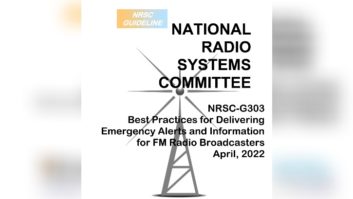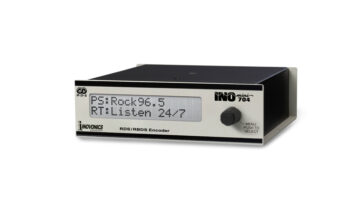The advent of RadioText Plus, the arrival of a new generation of car receivers and the inclusion of FM tuners in mobile devices are among the reasons broadcasters may need to rethink their datacasting strategies.

This RDS summary shows the groups used and the current data in each. Figs. 1–3 are from an Audemat Navigator 100 mobile measurement system.
The RDS session at the spring NAB Show brought attendees up to date. Moderated by Steve Davis of Clear Channel, it featured Tony Peterle of Worldcast Systems; Alan Jurison of Citadel Broadcasting, who has written extensively about RDS in Radio World; and Jim Roberts of The Radio Experience/Broadcast Electronics.
Peterle began the session with an overview of the basics, reminding the audience that RDS data rate is quite slow, only about four times the speed of the old UPI teletype machines. From there it only gets worse as you factor in bits used for error correction, PI code, housekeeping and PS. This limited speed means that broadcasters may need to make compromises in order for all RDS services to function.
Peterle explained how group sequence determines the order and frequency of groups sent. For example, a station may transmit radio text (RT), group 2A; program service name (PS), group 0A; traffic message channel (TMC), group 8A; Open Data Applications Identifier (ODA), group 3A; and clock-time-date, group 4A.
With 20 percent of bandwidth allocated for each of the five group types, six of each group would be sent every three seconds. This is acceptable for TMC and RT, but will not work for scrolling PS, since six 0A groups in three seconds is not enough to defeat “scrolling-resistant” receivers.
The good news, Peterle added, is that groups 3A and 4A only need to be sent a few times a minute. By constructing longer group sequences, the impact of the 3A and 4A groups can be minimized.
Some data services such as emergency messaging need bandwidth when messages are being sent, but much less when the service is idle. Encoders with extended group sequence can reallocate bandwidth dynamically to emergency messages, and return it to other groups when the emergency buffer is empty.

The group sequence display shows each data group type as it is broadcast.
By managing the group sequence and the extended group sequence, a station has a better chance of providing listeners with a more robust RDS experience.
Dashboard phenomenon
The RDS receiver landscape has seen many changes, according to Alan Jurison.
RDS is now almost exclusively an automotive phenomenon. Low- and mid-priced RDS table radios and portables seem to be disappearing, leaving text displays only on high-end receivers.
Most modern auto receivers feature bigger displays, with PS and RT fields shown together. Most support RT+. There is no standard for how RDS receivers display text, so it is wise to view your station’s datacasting display on several receivers to make sure you’re coming across the way you intend.
Jurison showed displays from several radios to make the point that broadcasters need to be clear about the differences between PS and RT.
With older, inexpensive receivers such as the DenonTU-1500RD, the display will not fit 64 characters, so it scrolls RT. Because the RT is scrolling, many confuse it with dynamic PS. These older receivers caused many broadcasters to be PS-focused.

RDS group count indicates how much bandwidth each type of group occupies.
Newer radios, however, support RT equally, if not better than PS. To ignore RT is to ignore the user experience on newer radios.
He adds that some stations are still doing dynamic PS and are not transmitting RT at all. The radio displays Jurison showed made the point that stations without RT do not present themselves well on the newer receivers.
He adds that some of these newer receivers do not show the PS, and if you have static RT, they can no longer see dynamic content such as song titles. Stations doing dynamic PS should be sending dynamic RT as well.
New receivers emphasize RT over PS, meaning that your station should evaluate the RT sending rate of your RDS encoder. Factory defaults often have slow RT send rates. Since receivers often wait for RT to be sent twice, the process slows down dramatically, sometimes taking as much as 15 seconds.
Jurison also reminded the audience of RF and FCC issues surrounding RDS.
Guidelines for injection level recommend between 3 and 11 percent. Too low a level, and receivers may not decode RDS, while too high a level robs main channel modulation. With newer receivers, 6 percent injection is a good starting point. Levels should be set with a modulation monitor that supports RDS injection display.
FCC rules allow stations to increase total modulation 0.5 percent for each 1.0 percent of FM subcarrier injection, up to 110 percent maximum.
The RDS subcarrier must be synchronized with the pilot. Sync problems can cause issues with RDS reception. When properly synched, the modulation peaks of the RDS subcarrier will be slightly reduced, leaving more room for main channel modulation.
One of the hot topics for RDS, according to Jurison, is interfacing with EAS units so that alerts may be broadcast in text form. A few stations have hacked custom solutions, but manufacturers are just beginning to develop firmware so that EAS and RDS units can talk to each other. No standard for interoperability exists yet.
Jurison said Inovonics has firmware available for download to enable its 730 encoder to interface with Sage and Digital Alert Systems devices. The EAS receiver truncates alert messages to 64-character format, and sends it to the RDS encoder via serial or TCP/IP connection.
Revenue enhancement
Roberts began his presentation with tagging. Fifth- and sixth-generation iTunes devices support RT+ tagging of artist and song title. Affiliate tagging is no longer supported for RDS.
He then described revenue opportunities offered by RDS. They include high-impact ads, such as running messages all day for a single advertiser. An example would be ads for a flower shop right before Mother’s Day.
Linked events involve running RDS text at the same time as a commercial. Messages may be the advertiser’s phone number, a coupon code or Web address. With HD, graphics can be included.

Alan Jurison’s presentation included a discussion about the confusion between PS and RT.
Roberts adds that what stations should not do is clutter their RDS with an endless barrage of ads, or “radio spam,” lest listeners become saturated and ignore RDS altogether.
HD Radio offers enhancements, most notably the Artist Experience, which allows listeners to view graphics on receivers with compatible displays. Possible applications include station logos, album art and sponsor graphics. Artist Experience also will allow broadcasters to post advertising images linked to traditional audio advertisements.
In many cases, the data to be used for RDS may need to be enhanced. This is especially true of information that was put on automation systems before the days of RDS. Examples include editing inappropriate song titles; adding missing information such as album names; and adding iTunes or other store ID.
Roberts adds that solutions include manually cleaning up the automation database; substituting a local database external to automation; employing a corporate database group-wide; and using third-party databases such as iTunes, Amazon or TagStation.
Opportunities exist to extend datacasting by exporting “now playing” data onto social networking sites. For example, stations can set up a separate Twitter account where listeners can “favor” certain songs.
Roberts concluded with applications of crowdsourcing in radio. New services give listeners the opportunity to make real-time decisions on what music airs on a station.
Key players in radio crowdsourcing include LDR.1, enabling listener input several times an hour; LDR.Takeover, allowing entire dayparts with listener control; Jelli, a syndicated platform which integrates with the station, enabling real-time engagement only when the show is on the air; and CrowdControl from The Radio Experience, which lets listeners vote for individual songs, or collectively program entire hours of your HD multicast channels.
Tom Vernon is a longtime contributor to Radio World. Read Alan Jurison’s RDS article series online.












